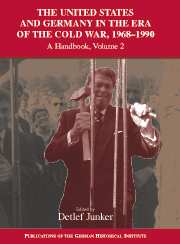Book contents
- Frontmatter
- POLITICS: Détente and Multipolarity: The Cold War and German-American Relations, 1968-1990
- SECURITY: German-American Security Relations, 1968-1990
- 1 A Limit to Solidarity-Germany, the United States, and the Vietnam War
- 2 NATO Strategy and the German-American Relationship
- 3 Differences on Arms Control in German-American Relations
- 4 The NATO Double-Track Decision, the INF Treaty, and the SNF Controversy - German-American Relations between Consensus and Conflict
- 5 The Shifting Military Balance in Central Europe
- 6 The Transfer of American Military Technology to Germany
- 7 German-American Intelligence Relations: An Ambivalent Partnership
- 8 No Unity Without Security: The Security Features of German Unification
- ECONOMICS: Cooperation, Competition, and Conflict: Economic Relations Between the United States and Germany, 1968-1990
- CULTURE: Culture as an Arena of Transatlantic Conflict
- SOCIETY: German-American Societal Relations in Three Dimensions, 1968-1990
- 1 “1968”: A Transatlantic Event and Its Consequences
- OUTLOOK: America, Germany, and the Atlantic Community After the Cold War
- Index
7 - German-American Intelligence Relations: An Ambivalent Partnership
Published online by Cambridge University Press: 05 January 2013
- Frontmatter
- POLITICS: Détente and Multipolarity: The Cold War and German-American Relations, 1968-1990
- SECURITY: German-American Security Relations, 1968-1990
- 1 A Limit to Solidarity-Germany, the United States, and the Vietnam War
- 2 NATO Strategy and the German-American Relationship
- 3 Differences on Arms Control in German-American Relations
- 4 The NATO Double-Track Decision, the INF Treaty, and the SNF Controversy - German-American Relations between Consensus and Conflict
- 5 The Shifting Military Balance in Central Europe
- 6 The Transfer of American Military Technology to Germany
- 7 German-American Intelligence Relations: An Ambivalent Partnership
- 8 No Unity Without Security: The Security Features of German Unification
- ECONOMICS: Cooperation, Competition, and Conflict: Economic Relations Between the United States and Germany, 1968-1990
- CULTURE: Culture as an Arena of Transatlantic Conflict
- SOCIETY: German-American Societal Relations in Three Dimensions, 1968-1990
- 1 “1968”: A Transatlantic Event and Its Consequences
- OUTLOOK: America, Germany, and the Atlantic Community After the Cold War
- Index
Summary
INTRODUCTION
Nations exist in a world of threats and opportunities. Their leaders, if they are responsible, seek knowledge - and, ideally, foreknowledge - of these conditions, because the more accurate their understanding of global affairs is, the more they will be able to protect and advance their vital national interests. The goal of global awareness can be achieved only through the painstaking collection (from open and concealed sources) and thorough assessment of information about key events, circumstances, and personalities across the globe. This collection and “analysis” is the essence of “intelligence,” as that term applies to affairs of state.
For the United States and West Germany during the Cold War, the primary focus of their separate and occasionally joint intelligence activities was the Soviet Union - the one adversary with the capacity to annihilate their respective societies in a hailstorm of nuclear missiles. This article explores the tensions and problems involved in the efforts by officials in Bonn and Washington to carry out operations against this and other common targets by sharing intelligence responsibilities. The period examined extends from the opening of German Ostpolitik in 1969 until the fall of the Soviet Union in 1990.
- Type
- Chapter
- Information
- The United States and Germany in the Era of the Cold War, 1945–1990A Handbook, pp. 171 - 177Publisher: Cambridge University PressPrint publication year: 2004

